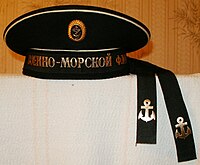Sailor cap

A sailor cap is a round, flat visorless hat worn by sailors in many of the world's navies. A tally, an inscribed black silk ribbon, is tied around the base which usually bears the name of a ship or a navy. Many navies (e.g. Germany) tie the tally at the rear of the cap and let the two ends hang down to the shoulders as decorative streamers. In the Royal Navy the tally is tied off in a bow over the left ear and in the early 20th century it was customary when going on shore leave to tie a small coin in the bow to make it stand out. In wartime, as a security measure, many navies replace the name of the ship with a generic title (e.g. "HMS" = "His/Her Majesty's Ship" in the Royal Navy or "South African Navy"). The cap may be further embellished with a badge, cockade or other accessory. Visorless caps of this kind began to be worn in the mid 19th century.
The more rigid type of sailor hat with a wide, flat crown is also known as square rig (this refers generally to a type of
History
The sailor cap was first introduced in September 1811 as a part of the uniform of the Imperial Russian Navy (bezkozyrka, Russian: бескозырка, 'non-peaked hat'), at the same time as an identical forage cap was adopted by the Imperial Russian Army.[2] All ranks of the Russian navy of this period wore military style uniforms[3] and the bezkozyrka was a useful development of the peaked cap in practical application to marine conditions.
The French Navy's version of the sailor cap, the bachi with its distinctive red pompom on top, was adopted about 1848.[4] Worn initially as an ordinary duty alternative for a formal leather hat with turned up side, the cap has survived as a dress item until the present day. Some navies which share similar traditions as the French Navy also adopted the bachi, but sometimes with a pompom of different colour (France, Benin, Guinea, Togo, Cameroon, : red pompom, but Senegal and Mauritania: green pompom, Lebanon: light-blue pompom). Malagasy sailors wear a bachi with a red and green pompom, according to national flag colours. The Belgian Navy adopted the same pattern of cap, light-blue pompom, but with trailing ribbons as well, on 29 March 1939,[5]. They finally stopped using the pompom ornament during the Second World War, to keep only the ribbons until our current days. The Irish Navy wear seaman's caps topped by blue pompoms.
Known as the "flat hat" or "Pancake cap" the U.S. Navy's version of the blue woolen sailor hat described above was first issued in 1852. Generally superseded progressively by the white cotton hat of the working uniform also known as a "Dixie hat" during World War II, the flat hat continued to be issued but seldom worn, until officially formally abolished in April 1963.[6]

In the
The
Images
-
China "square rig" or "pork pie" hat
-
Royal Norwegian Navy cap
-
French National Navy "bachi" bonnet (red pompom)
-
Congo National Navy "bachi" bonnet (red pompom)
-
Togolese National Navy "bachi" bonnet (red pompom)
-
Senegalese National Navy "bachi" bonnet (green pompom)
-
Irish Naval Service seaman's caps (blue pompom)
-
Polish Navy cap
-
United States "dixie cup" hat
-
Polish sailors wearing "dixie cups"
-
Australian sailor in 1940 with the British pattern seaman's cap
-
Royal Thai Navy sailors with sailor cap
-
Royal Navy sailor with British seaman's cap
-
World War II Royal Canadian Navy sailor, showing the British pattern blue cap
-
Royal Canadian Navy sailors during World War II, with the white cap, worn in the summer or in the tropics
See also
References
- ISBN 0-684-16304-7.
- ISBN 0-85045-737-8.
- ISBN 0-684-16304-7.
- ISBN 0-684-16304-7.
- ^ Liliane and Fred Funcken, pages 150 and 153 "L'Uniforme et les Armes des soldats de la guerre 1939-45, tome 2 Casterman 1973
- ^ "Sailors Liked the "Flat Hat" and Wore It for 111 Years - Defense Media Network".
- ISBN 978-1-84797-845-5. Part One
- ^ Brayley 2014, Part Two Sect.2
- ^ "Dress instructions Chapter 5 Orders of dress".














